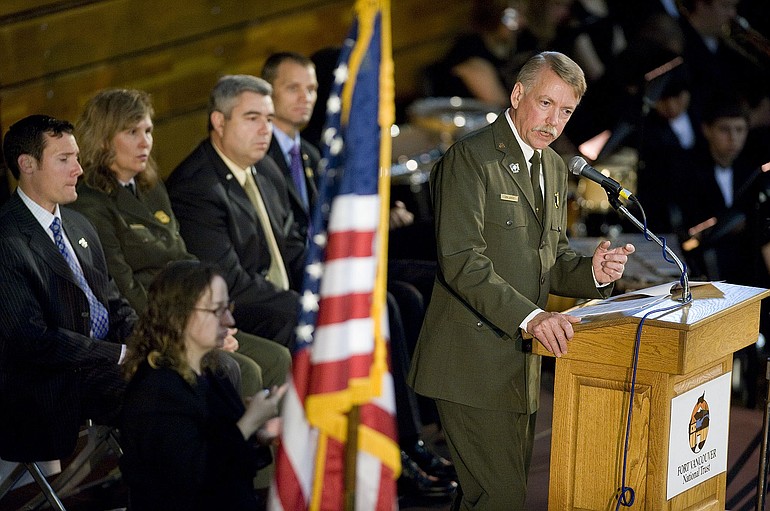Jonathan Jarvis mixed historical lessons with a ripped-from-the-headlines immediacy in his 2010 Marshall Lecture on Thursday at Hudson’s Bay High School.
The director of the National Park Service flew to Vancouver from Mobile, Ala., where he’s part of the federal response to the oil spill in the Gulf of Mexico.
As an incident commander, Jarvis oversees more than 400 Department of the Interior employees along the Gulf Coast. And they’re part of more than 17,000 people working to stop the spill or limit its damage.
“The response is in the spirit of George C. Marshall,” Jarvis told the crowd in the Bay gymnasium. “In a crisis, he stood up and served.”
One crisis was the Great Depression, when Gen. Marshall was a U.S. Army commander at Vancouver Barracks from 1936-38. Marshall oversaw the Civilian Conservation Corps public works program in the Northwest.
“It was the height of the Great Depression. One-fourth of Americans were out of work, and those with jobs were afraid of losing them,” Jarvis said.
“The CCC offered millions of young men a paycheck and the hope that the next day would be better than the last.”
o National Park Service sites had about 280 million visitors in 2009. There is a national park in every state except Delaware.
Several of those men were seated in the front row, including Pat Sutherland, who joined the Civilian Conservation Corps after graduating from high school in 1939.
“It was the greatest experience a 17-year-old could have,” the Vancouver resident said. “I had a job, and the responsibility to do it right.”
Sutherland worked near the Columbia Gorge community of Carson, building roads, planting trees, felling trees and cutting down snags to prevent lightning strikes.
“I made $30 a month, $25 of which went to my folks. That was the equivalent of a week’s pay for my dad,” Sutherland said.
Daniel Snyder was part of a CCC company that worked on Mount Hood.
“Our company helped with the water system at Timberline Lodge, and our stone masons did some of the roadside stone work,” said Snyder, a resident of Aumsville, Ore., near Salem.
“We also built a ski area south of Government Camp,” Snyder said.
A lot of their work established the groundwork for America’s parks, which is why Jarvis nodded toward those former CCC workers and said, “One of my responsibilities as director is to take care of your legacy.”
Jarvis became the 18th director of the National Park Service in October, capping a career that began in 1976. He served at several sites in the Northwest, including Crater Lake National Park in Oregon, and North Cascades and Mount Rainier national parks in Washington.
In his introduction, Vancouver Mayor Tim Leavitt called Jarvis “the chief caretaker of America’s treasures,” including “Mount Rushmore, the Liberty Bell, the Grand Canyon and the Fort Vancouver National Historic Site,” a block south of the Hudson’s Bay campus.
And those are just a few of the 392 units in the National Park Service.
“They’re a collective expression of who we are as a people, and an aggregate of what we value most about ourselves,” Jarvis said.
They include scenes of splendor and sites of significance. But whether it’s responding to natural beauty or “reflecting on our bloodiest battles like Gettysburg, be inspired,” Jarvis urged.
“Be rejuvenated. Be one of those people who make a difference.”
The Marshall Lecture is part of the “Celebrate Freedom” program presented by the Fort Vancouver National Trust.




